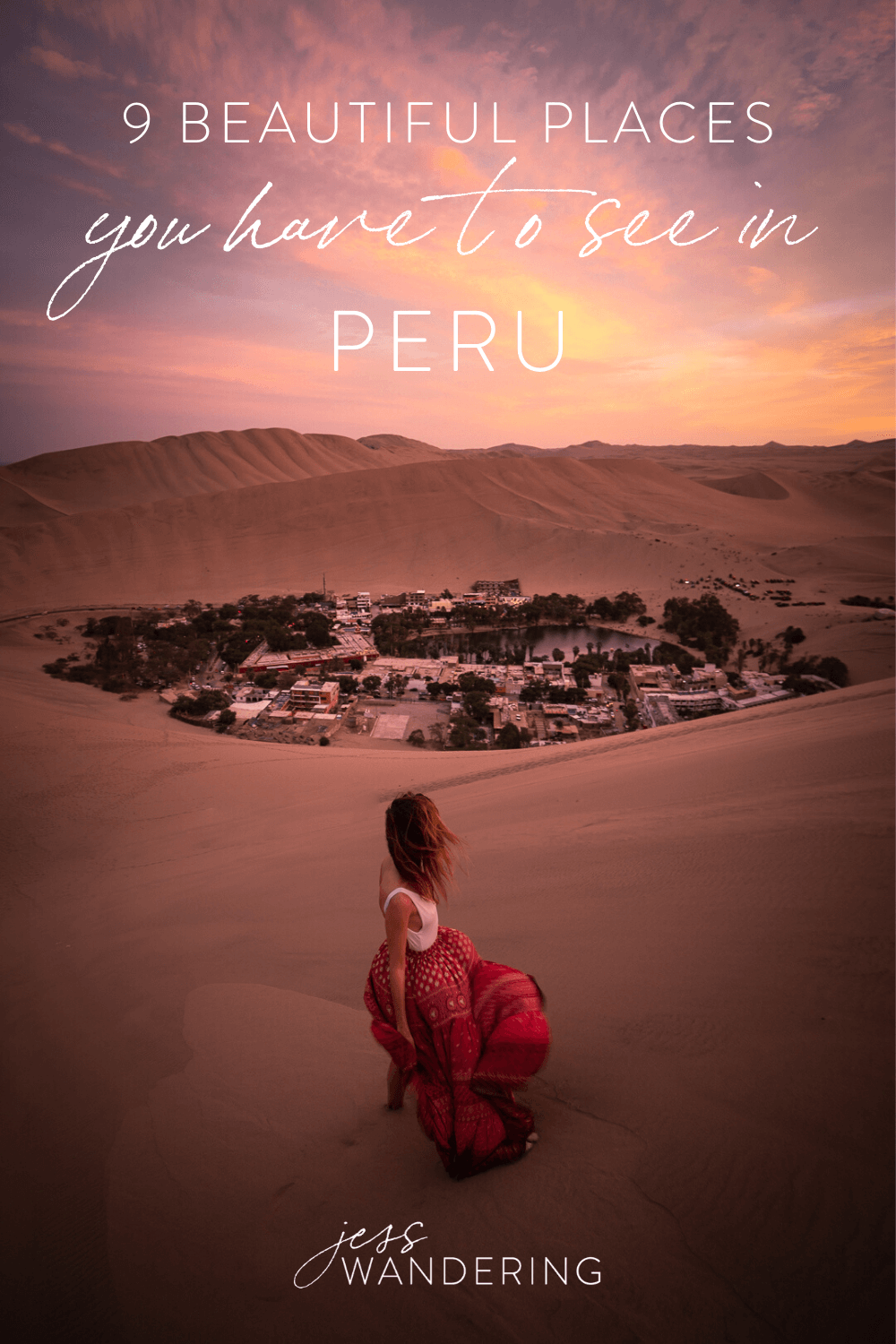
Photos In Collaboration with Quin Schrock
Why Visit Peru?
Oh, Peru, what can I say? In a real-life “who’s the fairest of them all” inquiry, Peru would be a serious contender. And that’s without having to resort to black magic. I’m frequently asked about my favorite place in the world, and while my answer is forever evolving, Peru is always toward the top.
Its combination of stunning natural beauty, rich cultural heritage, and friendly people makes it a hard destination to beat for nature lovers, those seeking rich culture and rich history.
For that same reason, it’s nearly impossible to come up with a definitive list of must see places in Peru. There are endless beautiful places to visit in Peru for first-time visitors and those who return to the natural wonders of the country. So, I’m not even going to try.
By no means do the locations in this blog post represent the last word on what you should see, or where you should go when you visit Peru. But they’re a darn great place to start!
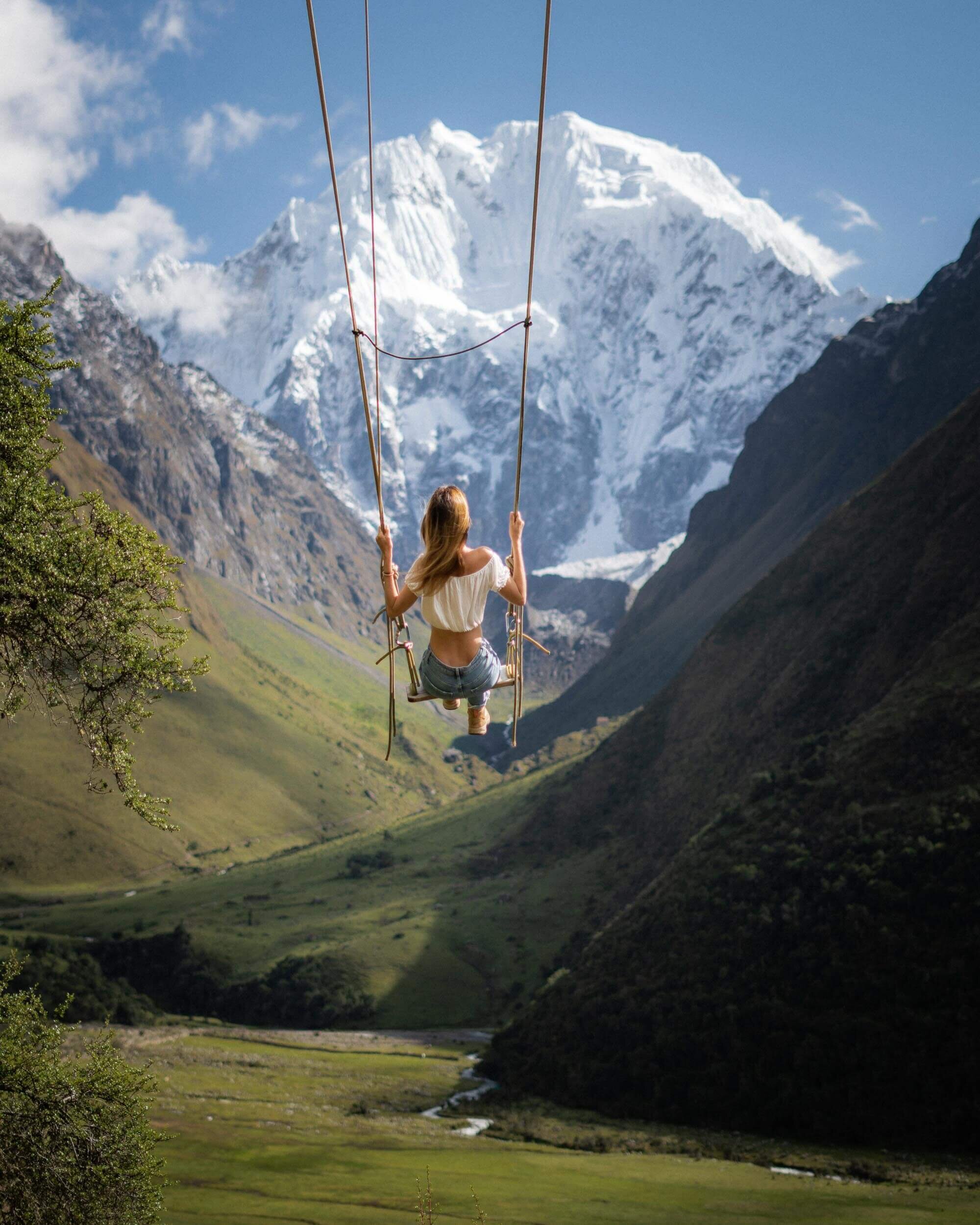
Extreme swinging at one of the hotels in the small village located in the valley below Humantay Lake.
Beautiful Places To Visit In Peru That Will Blow Your Mind
This was my second time to Peru. The first time was for two weeks. And that entire trip was spent preparing for and then completing the Cordillera Huayhuash Trek.
It was one of the most memorable experiences of my life, and it left me aching to experience more of Peru. And so I started planning my trip back before I had even left the country.
This time around we didn’t have any set plans, but we did have the van, so flexibility was on our side. While I have to admit that having our own transportation was amazing, you can see all of these beautiful places in Peru without it! All you need is a bus ticket, a little patience, and a sense of adventure!
1. Lake Parón
We arrived at Lake Parón just as the last light faded into the night. It was raining outside, and although we could detect a faint blue glow coming off the water below us, the view was disorienting in the dark. It was difficult to tell where the lake ended, and the mountains started, or if we were even in the right place.
The drive up to Lake Parón from the small toll station had taken almost two hours, moving at a painfully slow speed, over the gnarliest dirt road we’d experienced in Peru. And it almost hadn’t happened at all.
When we arrived at the gate up to the lake, it was closed, and a car full of fellow travelers was trying to turn around on the narrow road. They informed us that the road was only open from 8 am-2 pm. But if there’s one thing we had learned in South America thus far, it was this: If you don’t get the answer you want, just ask someone else. So instead of following suit and turning around for the day, we asked the man working at the entrance if we could pay to camp up at the lake in the van.
He gladly accepted, we paid the S/5 entrance fee, and we were on our way.
At the top of the road, we found a small visitor center complete with bathrooms, showers, and few bunk beds. The only thing missing was people. So we fell asleep to the soft pitter-patter of the rain on the van, hoping that the morning would bring clarity. And it did!
We woke to a clear view of the Cordillera Blanca’s snow-capped peaks framed by blue skies above, and an even more blue lake below. After taking a few pictures, we paid the now occupied visitor center S/20 to take one of the rowboats out for a spin – a lot more difficult than one might imagine. When we were done struggling with the boats, we took the 45 min. trail up to Mirador. If you had any doubts about Lake Parón’s exceptional beauty, it wouldn’t survive the views from the lookout.
By 11 am the small parking was filling up with tour buses, and we decided it was time to leave. But we both agreed, that there might not be a prettier place on earth that you can just drive right up to.
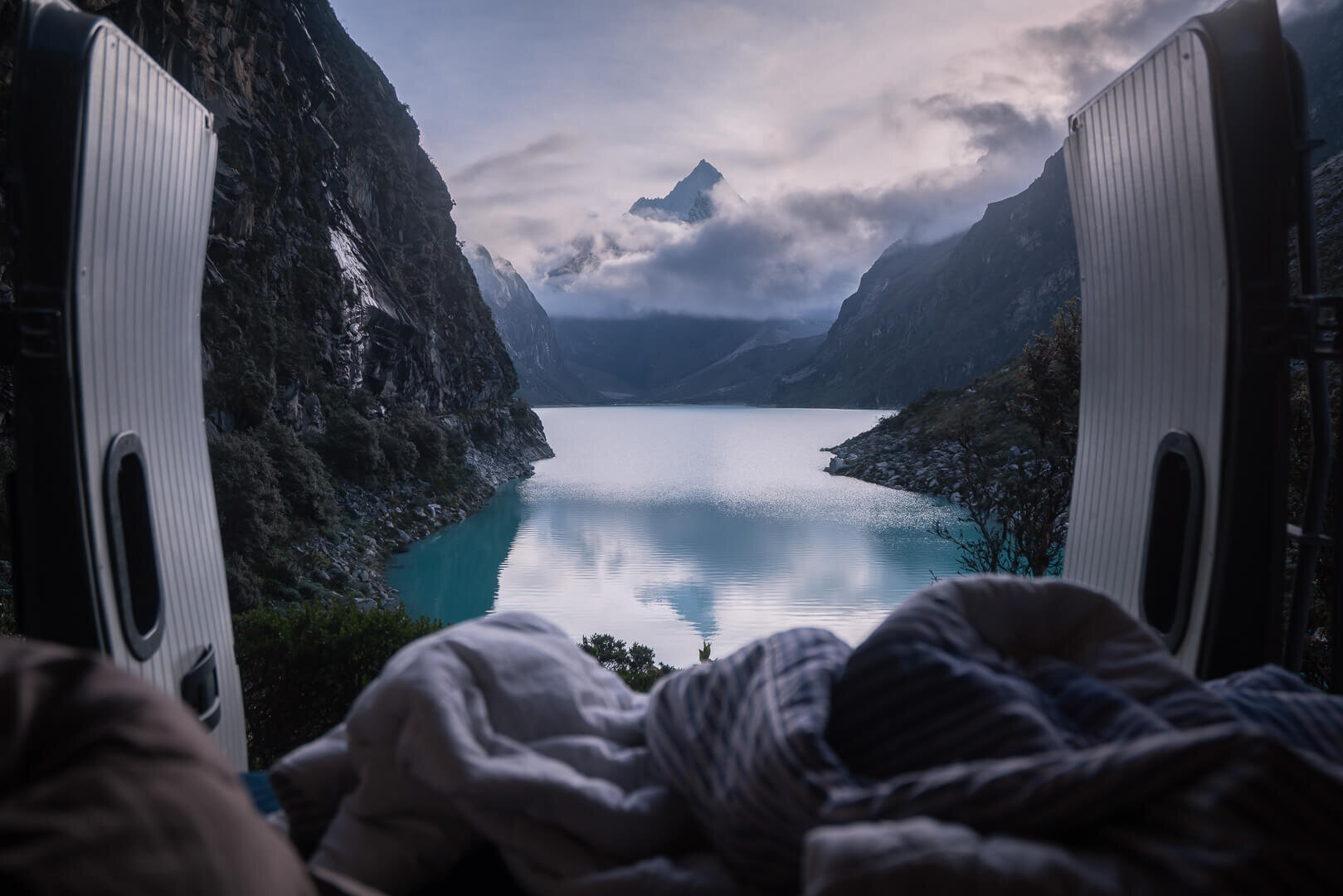
The view from the back of our van at Lake Parón.
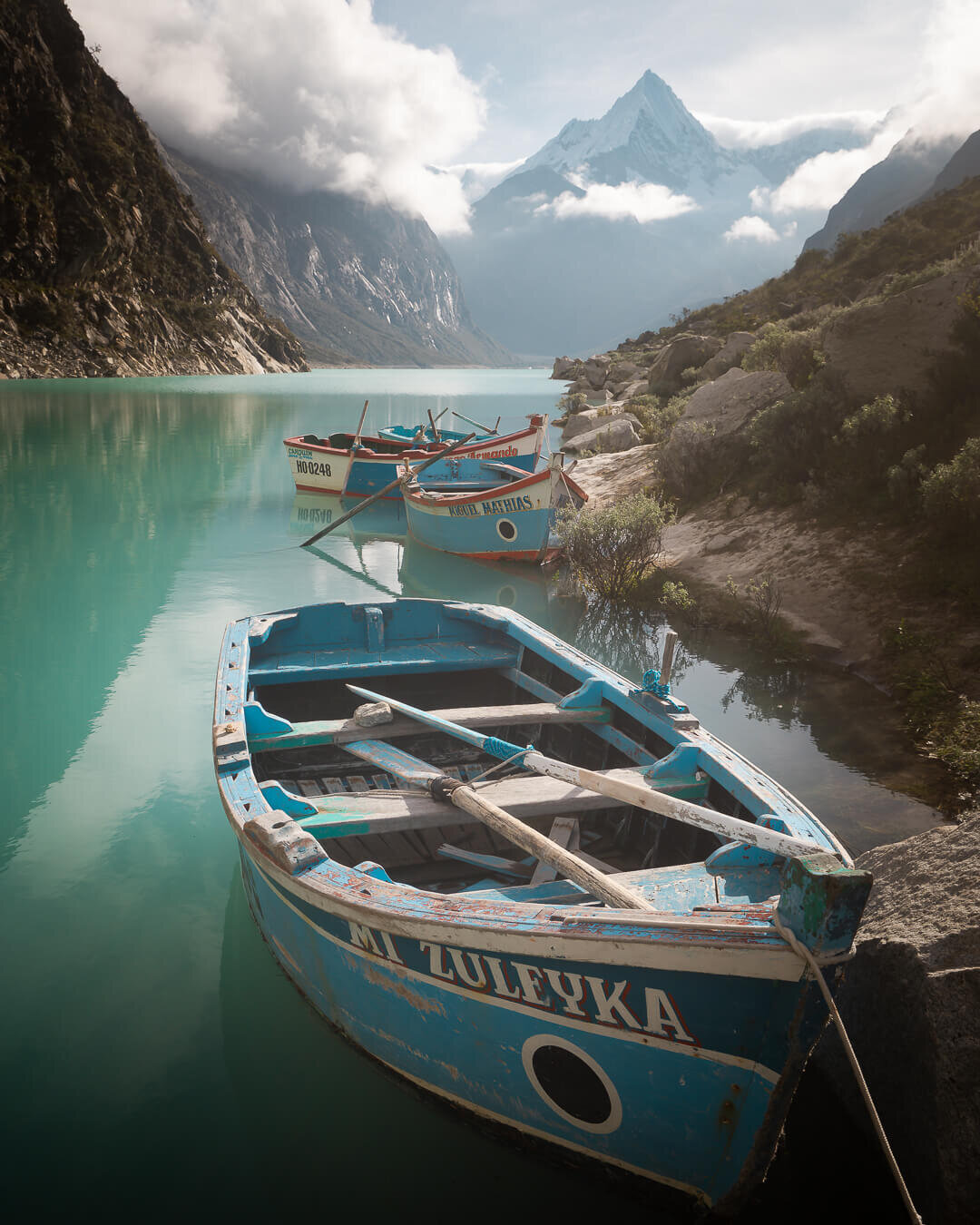
We spent the morning paddling around Lake Parón in one of these colorful row boats. You can see Mount Pirámide in the background.
Logistics:
Obviously we were traveling in our van, so logistics were much less complicated for us than most people traveling through Peru. That being said, you can get to Lake Parón independently or by taking one of the many tours from Haraz. If you go independently you will likely take a collectivo from Caraz to Pueblo Paron. From there, it’s a 5-minute walk to the trailhead, and then a long 10 kilometers up to the lake. The hike takes about 3 hours up and less than 2 hours to get down.
Alternatively, you can take a tour from Huaraz. Most of these tours leave around 8 am and take approximately 10 hours. It’s a very long day-trip, and most of it is spent in the car. But as long as the weather cooperates, the views are well worth it!
2. Laguna 69
Two days after arriving in Peru’s capital city, Lima, and one very long overnight bus to Huaraz later, we decided it would be a good idea to hike to Laguna 69. It was not. And I had the headache to prove it.
We were scheduled to start the 10-day trek around the Cordillera Huayhash in a couple days, and after reading multiple articles had decided to do a quick overnight at Laguna 69 to help acclimate to the altitude. By the time we reached the lake and set up camp, the only thing we could think to talk about was how many Advil we were allowed to take at once. On top of that, we had arrived in a whiteout.
The famous blue lake was covered in a blanket of fog so thick I worried that it would never come out to play.
And the mountains – forget about it.
So we did the only things that two photographers with splitting headaches trapped in a tent can do: We went to bed.
When we woke up the next morning, exhausted from a fitful night of high altitude sleep, our headaches were worse, and the view was only marginally better. The mountain peaks were still nowhere to be found, but the bright blue water managed to peek through here and there as the fog blanket shifted around with the wind.
During a brief weather window, we dutifully took some photos of our campsite. More to document the experience than anything else at that point. As the sky turned an even more ominous shade of grey, we packed up our bags and hiked back down to the trailhead.
In hindsight, even with the less than ideal conditions, Laguna 69 is still an undeniably beautiful destination and one of the most unique places to visit in Peru. I certainly wouldn’t discourage anyone from doing it. But I might give myself a couple days to acclimate in Huaraz before deciding to camp at 4,600m! And by might, I mean you must, must, must acclimate before attempting Laguna 69. Trust me!
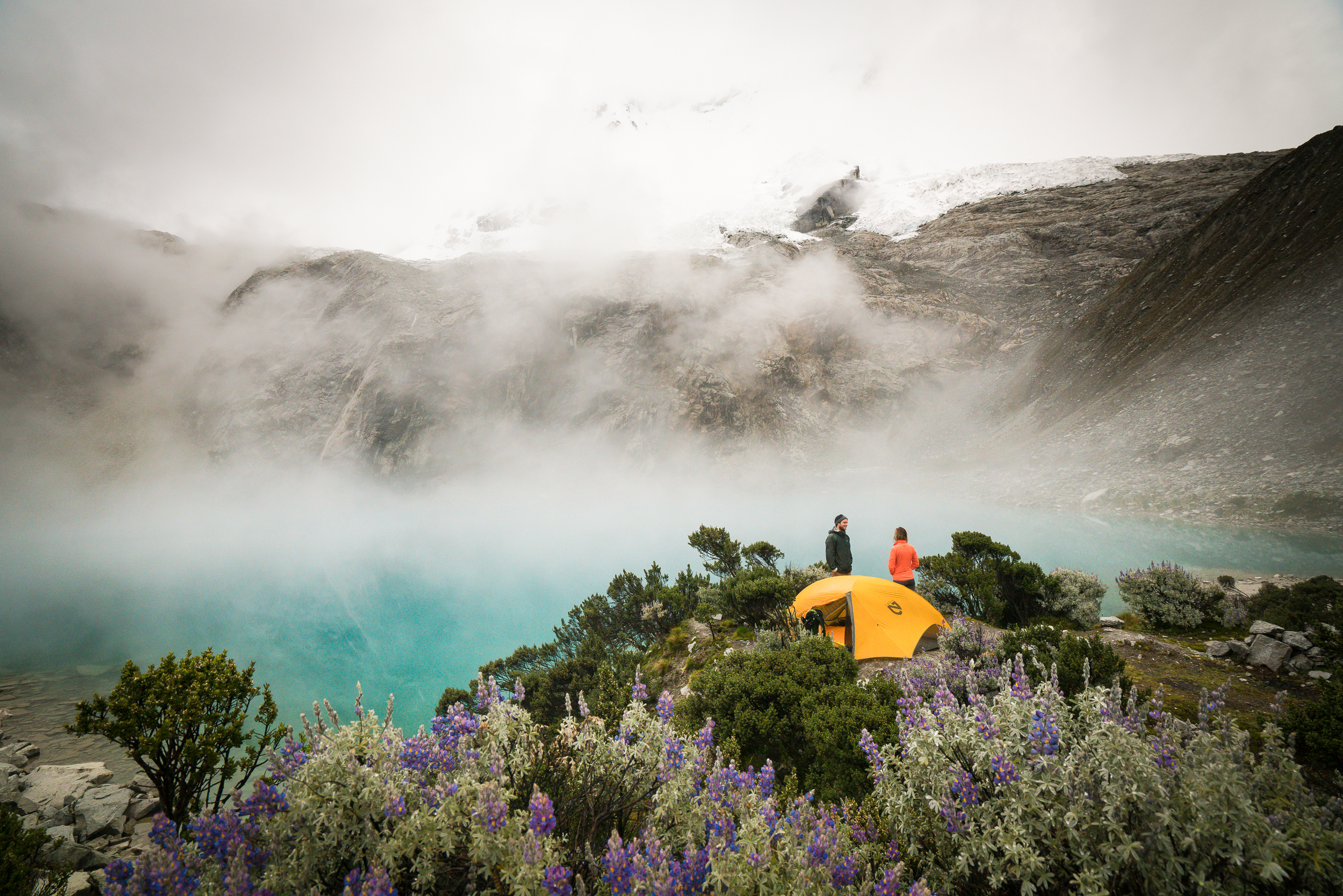
Foggy mornings at Leguna 69 near Huaraz, Peru.
Logistics:
There are three ways to do Leguna 69: Collectivo, Tour, or Taxi. There are pros and cons to each option, but ideally, they all start and end in Huaraz. We ended up going with the collectivo option and had no issues. However, it helped that we spent the night up at the lake, more than enough time to get back to the trailhead before the last Collective departed for Huaraz.
If you are planning on day-hiking to Leguna 69, the timing is a lot dicier – some even say impossible. Going with a tour is probably the safest and the best way (and least expensive) out of the three. The only downside is that you might find yourself waiting around for other people to finish the hike long after you’re ready to hit the road. And of course, a taxi is the most convenient – but you’ll pay for it.
3. Cordillera Huayhuash
The Cordillera Huayhuash (pronounced ‘why-wash,’ with the second syllable rhyming with ‘rash’) occupied a space in my sub-consciousness before I knew its name. I’d fallen in love with photos before I knew where it was. And I planned theoretical trips to the razor-sharp peaks, bejeweled alpine lakes, and rock faces in those photos before I knew they were all located in the same location – The Cordillera Huayhuash.
Needless to say, expectations were high. And despite several things conspiring against us during our Cordillera Huayhuash Trek, it was worth every step to visit one of the most beautiful places in Peru. To read more about our experience on the Cordillera Huayhuash Trek, click here.
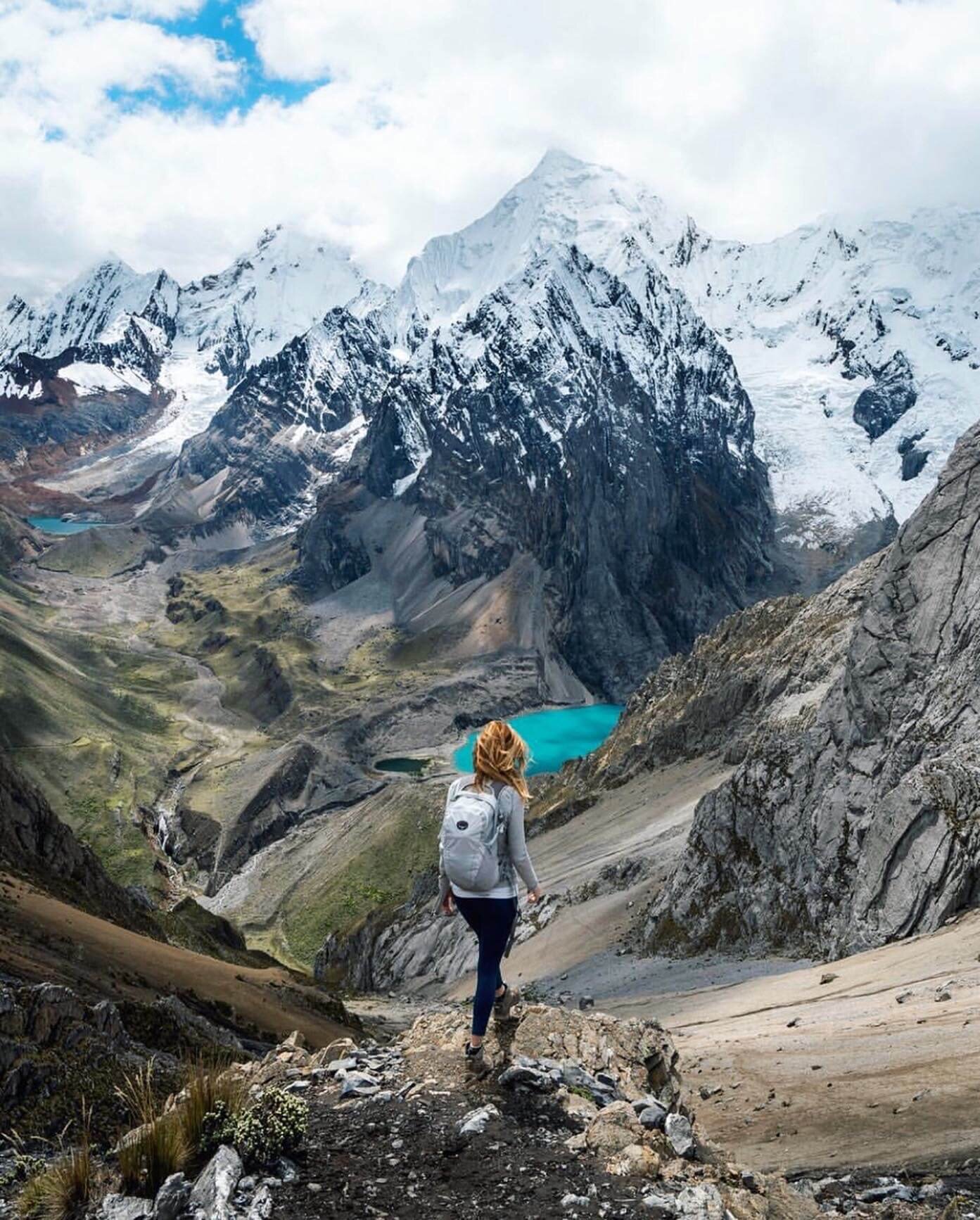
The view from San Antonio Pass on the Cordillera Huayhuash Trek in Peru.
Logistics: Commonly considered one of the 10 best-hiking circuits in the world, The Cordillera Huayhuash is approximately 130km, and is generally completed in 8-12 days. Theoretically, it is possible to do the Cordillera Huayhuash Trek trek independently, but I wouldn’t recommend it. For so many reasons, including difficulty, altitude, and route finding. But perhaps most importantly, I can pretty much guarantee that you will have a better time if you hire an experienced guide. Plus, it’s a great way to practice responsible travel by supporting local businesses.
4. Huacachina
Driving into Huacachina, I couldn’t shake the feeling that I had somehow trespassed onto the set for the next installment of Mad Max. The air buzzed with the sound of dune buggies in the distance and sand-covered every surface of the town creating sand drifts high enough to bury many of the town buildings alive.
We parked the van on the street and slowly made our way toward the dune buggy tour operators at the far end of town. We had arrived only an hour or so before sunset, and time was of the essence. I had wanted to take a sand buggy tour.
It looked fun, adrenaline-packed, plus, I’d never done anything quite like it. But it wasn’t in the cards this time around. Instead, we veered right, up past the water tower, and followed a trail in the sand that headed up one of the most massive sand dunes in the area.
Two steps forward, one sandy slide back, we made our way up the shifting dune. As we climbed, the wind picked up and howled around us, filling every nook and cranny and piece of camera gear with sand that would haunt us for weeks.
At the top of the dune, it was clear why Huacachina had become such a popular destination on Peru’s tourist trail. From the viewpoint, you could see the entire town below, with its palm trees and picturesque waterhole surrounded by miles of golden sand dunes. There’s no doubt that this is one of the most beautiful places to visit in Peru.
The perfect oasis. The view only improved as the sunset turned the sky bright orange and pink, before finally painting the entire world in a deep purple before making its final descent below the horizon.
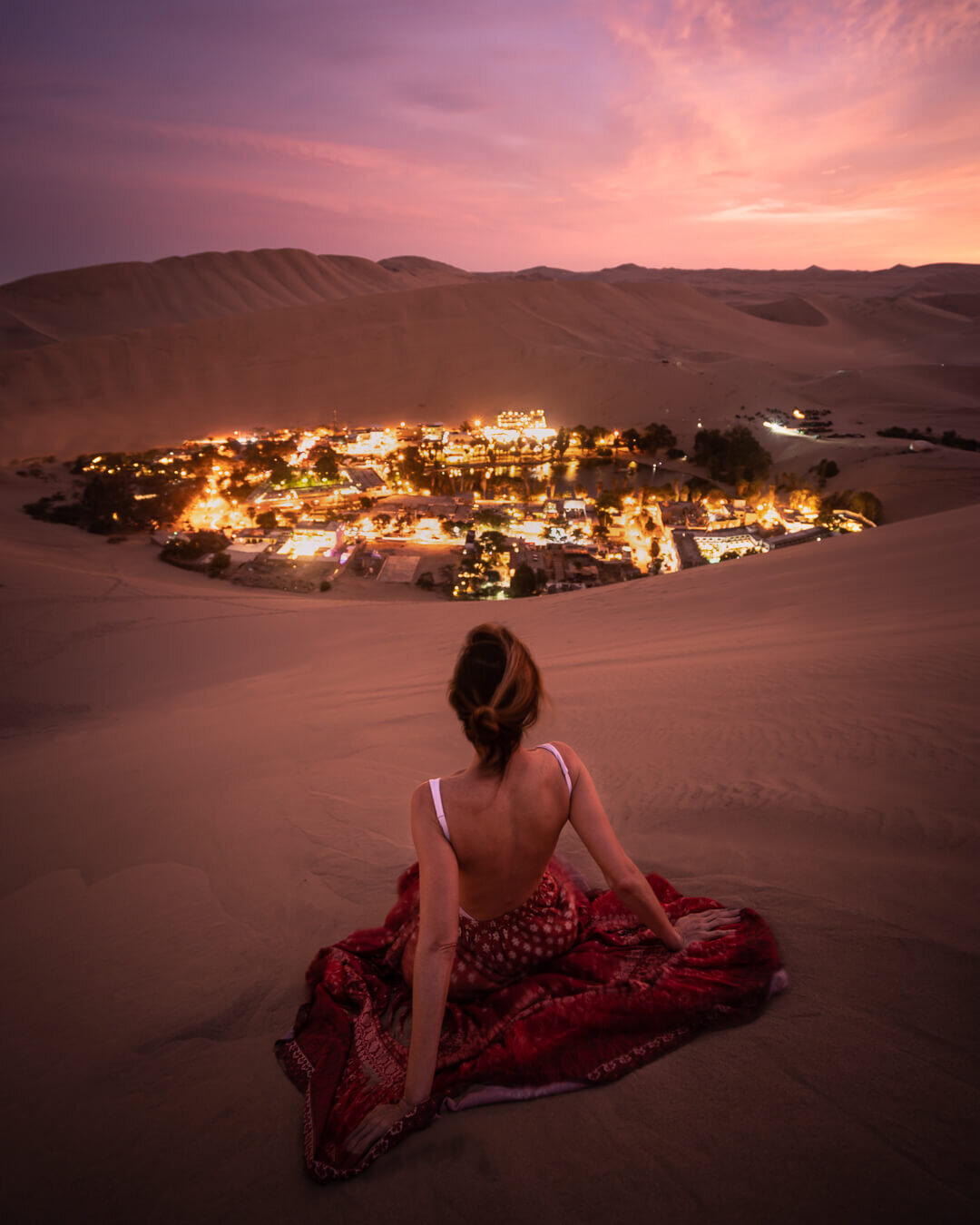
Huacachina just after sunset as all the lights down in town begin to turn on.
We ran back down the dune in the dark, caution to the wind, letting gravity do all the work this time around. I laughed like a little kid as my legs struggled to keep up with my tumbling body. The glowing lights of Huacachina guided our progress, like constellations in the sky. In the end, we were only in Huacachina for maybe two hours. But it’s two hours I’ll remember for a lifetime.
Whether you dune buggy or not, this is one of the best places to visit in Peru.
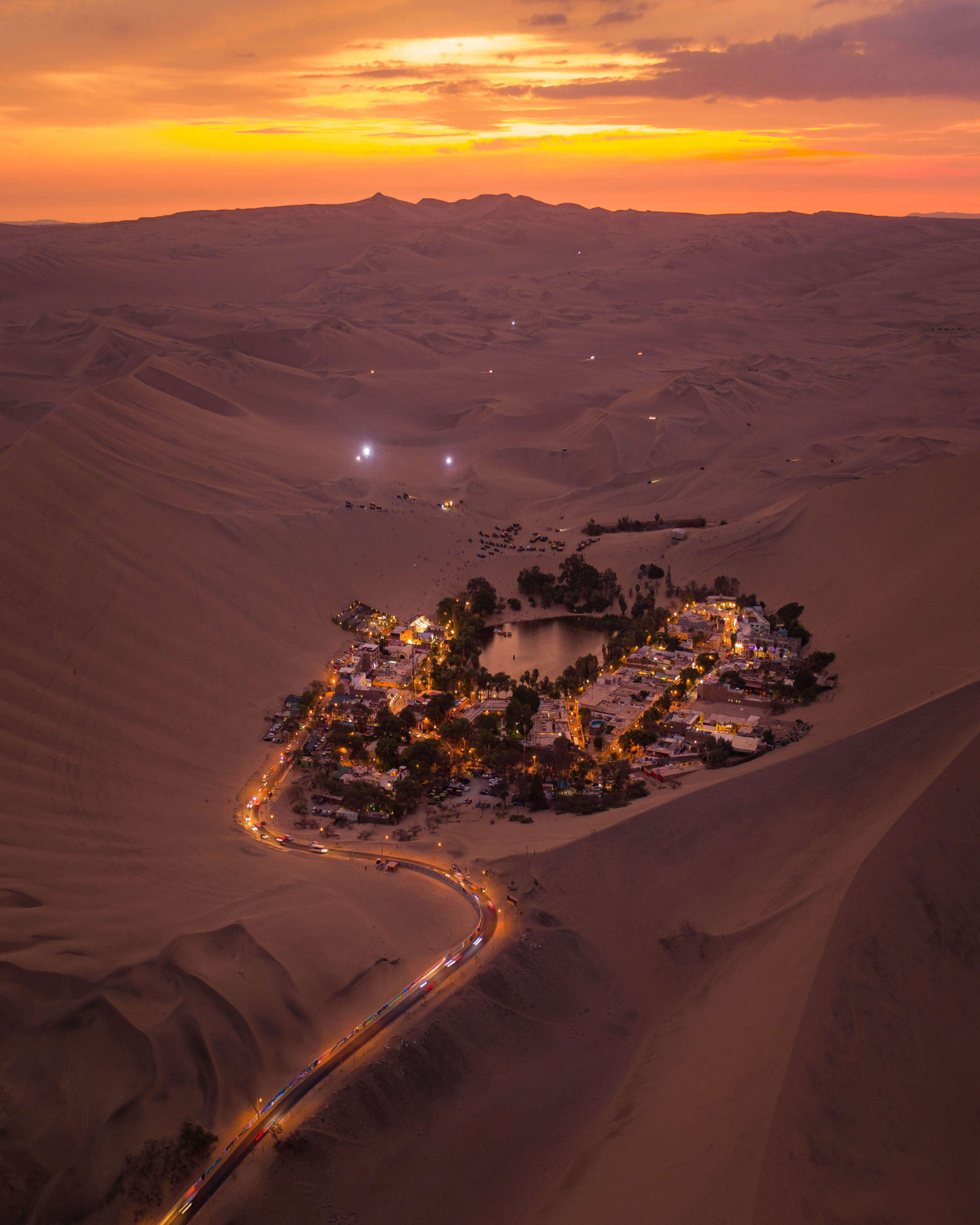
Aerial view of Huacachina at sunset.
Logistics:
Parking readily available in Huacachina. We drove by some parking lots, but the street parking seemed pretty safe as well. If you don’t have your own vehicle, Peru Hop is probably your best option. They offer transportation directly to Huacachina from Cusco and Lima. Alternatively, the closest city to Huacachina is Ica, and you can arrange a private ride from there.
5. Aguas Turquesas
Aguas Turquesas was, by far, the biggest let down of our most recent trip to Peru. But to be fair, it wasn’t Aguas Turquesas fault. . . we really should have known better.
We drove for two days straight to get to the brilliant blue tiered pools. I’d seen so many pictures of them on Instagram. We passed through the deepest canyons, huge mountain ranges, and deserts to get there. And as I watched the world drift by, I couldn’t help but notice that every body of water we passed was an unremarkable shade of brown.
I even turned to Quin once as Google Maps announced that we were only about an hour away from our destination; “how does the water go from brown to bright blue so quickly?” There was no response.
We arrived at Aguas Turquesas just before dark, so we decided to wait until the morning to make the short trek to the pools. That night, we fell asleep to the sound of pounding rain outside. When we woke up, the rain had stopped, the sun was shining, and we eagerly jumped out of the van to go explore the pools before anyone else arrived. No sooner had we started, we had to stop to remove the quickly accumulating mud on our shoes.
That should have been our first sign that the water might not be the color we were expecting (well that and the fact that none of the water we’d passed on the way was anything even resembling blue). But we waddled on, abandoning any hope of keeping our shoes clean.
The trail to the pools is maybe 20 minutes long. We moved slowly to avoid slipping in the mud. About halfway down, a farmer with a mud-covered lamb stopped to laugh at us. He exchanged a few words in Spanish with Quin, although I could only pick up a few words here and there. The look on Quin’s face said it all. The famous blue waters of Aguas Turquesas was not going to be blue at all. Instead, we had driven halfway across the country to look at a river of mud.
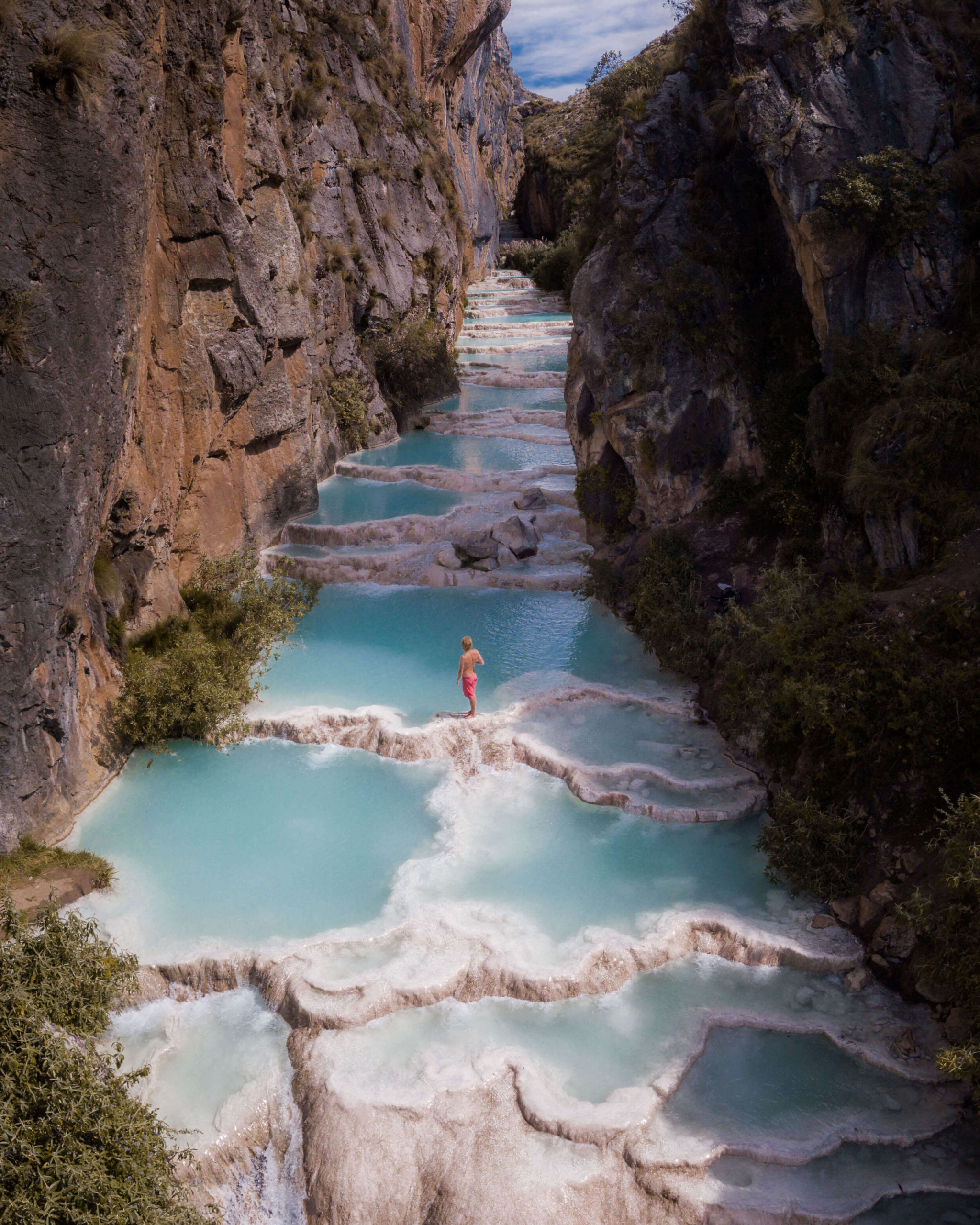
Quin was lucky enough to travel to Peru last year as well, and while he was there he took this photo of Aguas Turquesas with blue water. Trust me when I tell you that it looked nothing like that when we went in March!
Having come this far, there was no point in turning back. We slipped and stumbled down the rest of the trail until we reached the stairs up to the viewpoint. Out of stubbornness more than anything else, I insisted on climbing to the top. It wasn’t hard to see how the view that started to reveal itself as we climbed would have been beautiful under different circumstances.
From the viewpoint, you can follow a steep path down to the pools, or continue on another 10 minutes to the Mollepata waterfalls. I’d recommend doing both! There is no swimming allowed at the pools, but there are still plenty of photo ops available. That is. . . if you are there during the dry season!
Which brings me to my final point: DO NOT VISIT Aquas Turquesas during the wet season – typically October to April. Or at the very least check the weather beforehand. It’s one of the most unique places in Peru, but the best time to visit is the dry season.
Logistics: You can get to Aguas Turquesas independently or through a tour. If you don’t have your own vehicle, then it is easiest to join one of the many tours out of Ayacucho. They all offer pretty much the same service, so it’s not worth spending a bunch of time choosing between them. Tours generally leave around 8 am, and return around 7 pm. The drive typically takes about 4 hours in each direction, so prepare for a long day. There is a S/.5 entrance fee to the pools, and it’s best to have exact change.
6. Lake Humantay
We hiked up to Humantay three times in as many days. And if it didn’t kick my butt every time, I’d be lying. Now you might be asking yourself why? Why would you do such a thing? Well, it was March, rainy season in Peru, and we were caught up in a relentless game of cat and mouse with Humantay Peak.
Every morning we would wake up in the van, peak outside, see blue skies and unobstructed views, excitedly throw on our hiking boots and head up the trail. And every morning about halfway up the trail, a wall of clouds would materialize stealing our dreams of epic Instagram selfies with it.
Of course, we would begrudgingly hike the remainder of the path to the lake. Telling ourselves between gasps for more oxygen that the clouds would eventually part. But they never did. So we would slowly make our way back down to the van, grateful that we weren’t just arriving, after hours in a tour bus, only to find a mountain shrouded in clouds.
All that changed on the third day when we decided to try something novel. We woke up an hour earlier! And sure enough, we made it up to the lake just before the aforementioned wall of clouds began to envelop Humantay Mountain. Although to be fair, even if you can’t see the mountain, you likely won’t have any regrets.
The spectacular scenery and the lake itself are well worth the journey. We were just being particularly picky because, well, it’s what we do, and we had the luxury of time. Or at least we thought we did. Unbeknownst to us, a global pandemic was about to throw a major wrench into our plans – but that’s a story for another time.
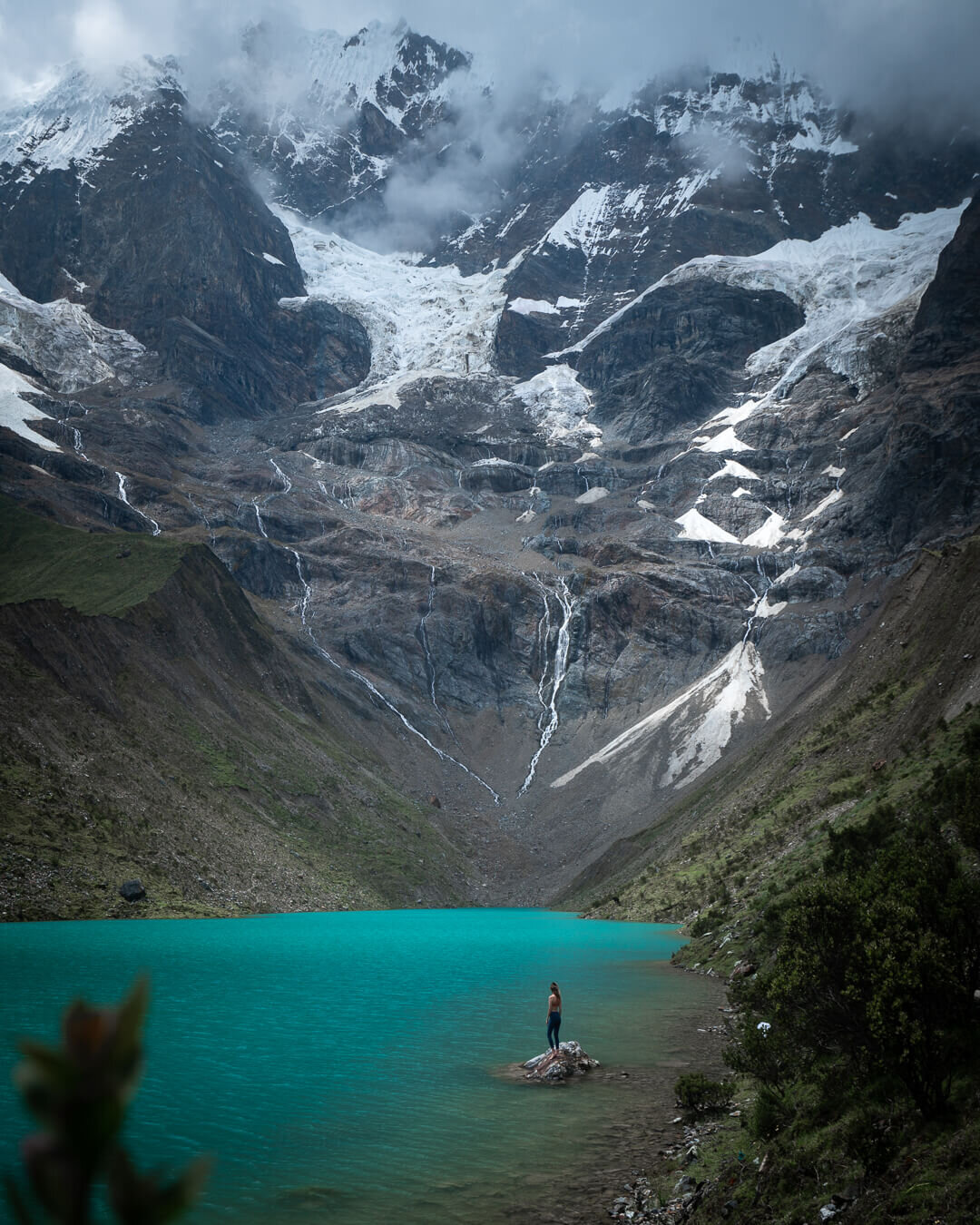
Waiting for the clouds to clear at Lake Humantay.
Logistics:
If at all humanly possible, avoid taking a tour bus to Humantay Lake. Every day I counted the vans and buses in the parking lot, and by 1 pm there were generally between 20-30. That’s at least 20 vehicles all carrying 10-20 people. And just in case your math is failing you, that means by late morning there is a minimum of around 200 people at the lake. And this was in the middle of a week, during the wet season.
The good news is that if you get to the lake before say 9 am, you will likely have it all to yourself. Now I understand that most people will not have their own vehicle. No worries! Plan on spending the night in the small village at the base of Humantay – Soraypampa. From there, you can wake up early and complete the 1-ish hour hike up to the lake before the hordes of people arrive!
7. Rainbow Mountain
I flopped down on the ground gasping for air. It was the fourth day of our Ausangate Trek, and we had chosen to veer off the traditional loop itinerary to catch the sunrise at Rainbow Mountain. Famed for its multi-colored stripes, the mountain was currently obscured by a wall of thick grey fog. At just over 17,000 ft, Rainbow Mountain was the highest point on our 4-day trek, and I was feeling it.
We had hiked to Rainbow Mountain in the dark, and now, as the fog drifted in and out of the lingering darkness, I caught my first peek-a-boo views of the surrounding landscape. In front of me, the first hints of rainbow-colored earth made its way through the fog. Behind me, the tip of Ausangate peeked over the pass we had hiked through the day before.
We had left camp around 4 am primarily to make it up to the viewpoint for the sunrise that never quite materialized. But that wasn’t the only good reason for an early start. We also wanted to avoid the crowds at Rainbow Mountain that others had warned us about.
After days of not seeing anyone outside our little crew, it seemed incomprehensible that this spot that had taken us 4 days of trekking to get to would be flooded by hundreds of selfie-taking visitors in a few hours. But our guide assured us it was true.
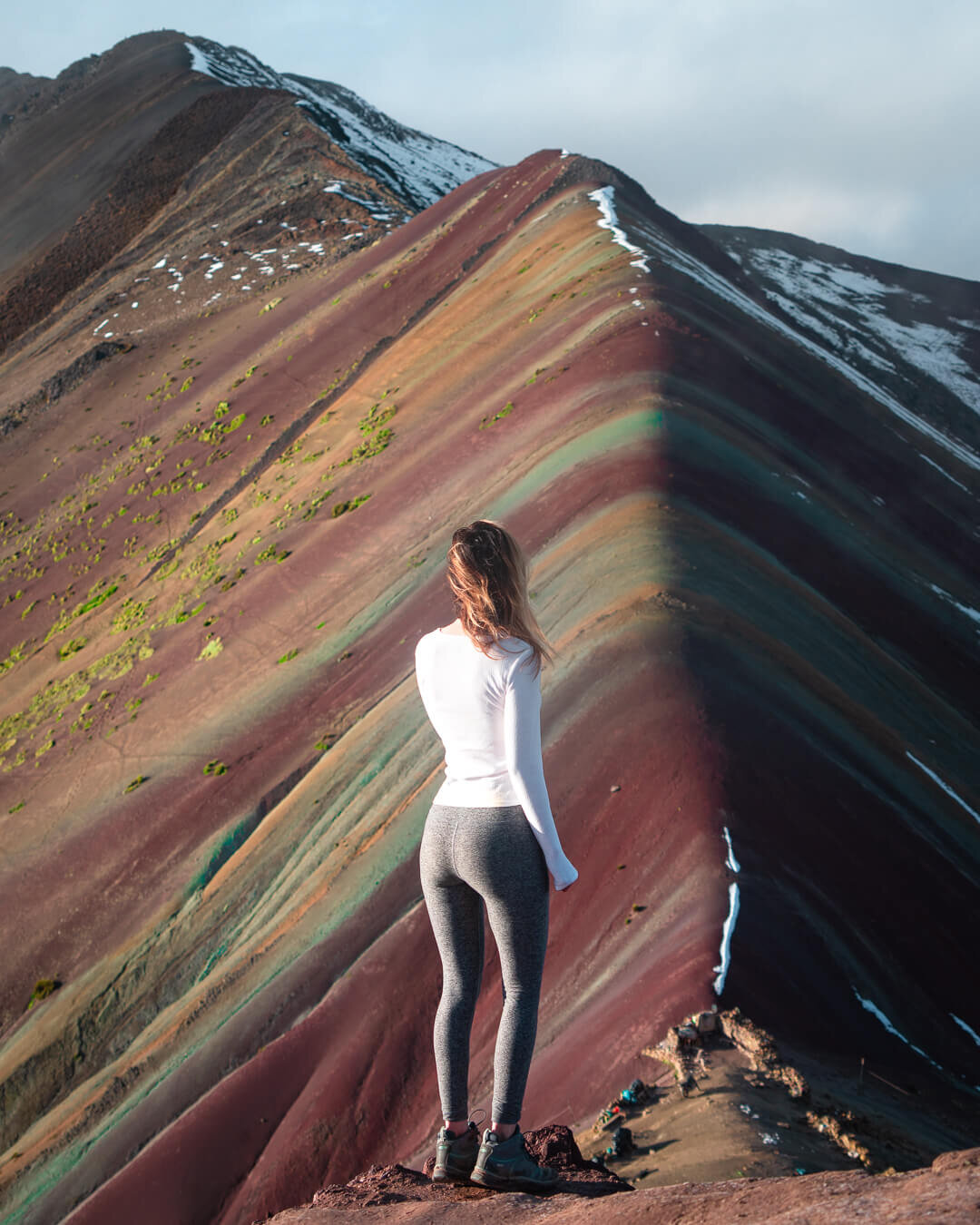
Rainbow Mountain just after sunrise and before all the guided tours arrive.
While we waited for the fog to lift, our guide told us about the ever-expanding network of roads that were being cut into the landscape to make this popular site more accessible. Each little community in a battle to claim the closest access to the colorful mountain – and in return, the financial benefit. Even a few years ago, Rainbow mountain was relatively unknown, now it’s one of the most popular places to visit in Peru.
Now, large tour buses scoop people up in Cusco every morning and deposit them at the end of whichever road has managed to sneak its way furthest up the mountain pass. Rainbow Mountain’s popularity isn’t hard to understand, the multi-colored stripes are unlike anything I’ve ever seen before (although YES, most photos you see are heavily Photoshopped to alter and highlight specific colors). But after spending maybe an hour at Rainbow Mountain taking pictures, we were ready to leave.
As we hiked down the mountain to meet the van that would take us back to Cusco, I was grateful our Rainbow Mountain experience had included everything that came before it on the Ausangate Trek, rather than just a very long bus ride.
Logistics: The majority of people arrive at Rainbow Mountain on a day trip from Cusco. On these tours, you will likely get picked up around 5 am, drive for 4 hours, hike for about an hour and a half to the Rainbow Mountain viewpoint, stay for about half an hour, and then turn around and do it all over again. So, if you have the time and resources, I’d highly recommend visiting Rainbow Mountain as part of a longer trek or experience in the area.
For more information about our experience at Rainbow Mountain and the trek we took to get there, check out my complete 4-Day Ausangate and Rainbow Mountain Trek guide!
8. Ausangate Trek
The Ausangate Trek is renowned for its otherworldly natural scenery. It’s considered by many to be one of the world’s best high-altitude treks. Recognized as sacred in Incan mythology, Ausangate features windswept valleys, snow-covered peaks, glaciers, panoramic views. . . basically an alpine wonderland.
Traditionally, the trek starts at the beginning of the Vilcanota mountain range and then loops approximately 70km around Ausangate. The trek is generally done over 5 days and 4 nights of moderately strenuous hiking. But we didn’t take the traditional loop route. We simply didn’t have time.
So after doing some research on the locations we wanted to photograph on the trek and talking with our guide at Killa Expeditions, we decided to do the first three days of the Ausangate Trek before heading to Rainbow Mountain and then hiking out. So basically, we missed out on the 4th day of hiking on the traditional route, and the 5th day which is primarily walking to the pickup spot and driving back to Cusco.
It was our hope that this truncated itinerary would give us the best bang for our buck on a tight timeline. As I sat on top of Rainbow Mountain on our 4th day, basking in the early morning light, there wasn’t a doubt in my mind that we had made the right decision. Although if life permits, I would love to complete the entire loop someday – just to say I did.
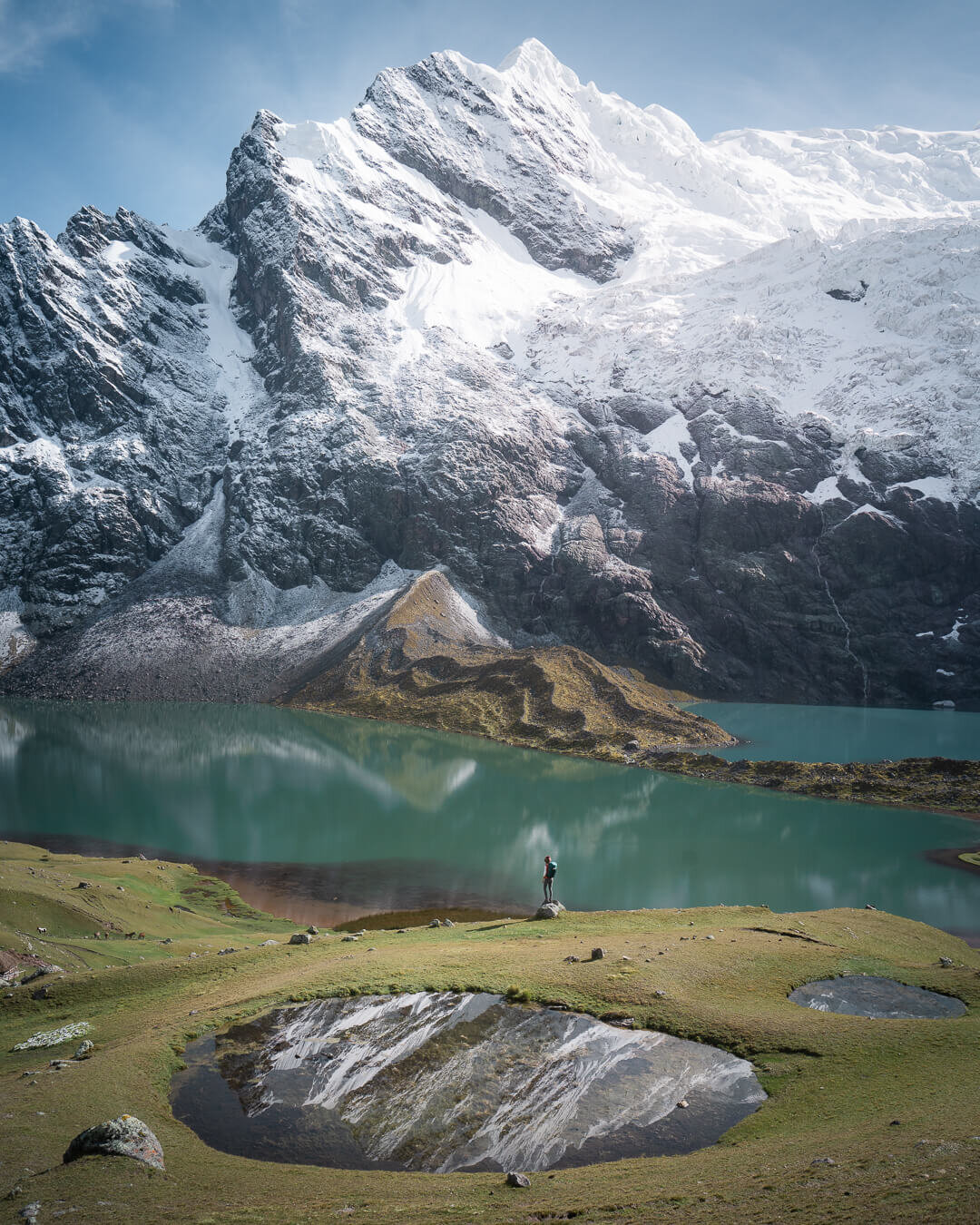
Doing the Ausangate Trek during the rainy season wouldn’t have been my first choice, but it did have it’s benefits – like all these beautiful reflective pools that aren’t there during the dry season.
Logistics:
The Ausangate trek can be done with or without a guide. Obviously, the right answer for you depends a little on who you are, how much long-distance trekking experience you have, and how you handle high altitudes. But putting all those variables aside, here’s my advice:
Do you need a guide to complete Ausangate? No. Do you want a guide? YES!
These are just a few of the many reasons I would suggest hiring a guide for the Ausangate Trek: (1) You don’t have to worry about route finding; (2) You’ll only have to carry a day pack; (3) Altitude sickness is the real deal; (4) Hot meals prepared for you by a cook, are always better than freeze-dried meals; and (5) It’s a great way to support the local economy.
For more information about our experience on the Ausangate trek, check out my complete guide for completing a 4-Day Ausangate and Rainbow Mountain Trek!
9. Machu Picchu
The truth is, we almost didn’t go to Machu Picchu. Quin had already been to Machu Picchu twice, it’s expensive, and my desire to experience a location that I’ve seen so many photos of has waned over the years. But not making the pilgrimage to this specific “wonder of the world” the last time I was in Peru, still haunted me.
So, in an attempt to rectify that particular regret, I now found myself riding the Inca Rail on my way to Aguas Calientes and one of Peru’s top tourist attractions. We did Machu Picchu independently taking a bus from Aguas Calientes up to the ancient ruins, and then walking around at our own pace.
I didn’t think this would be possible because I had read that along with many other regulations that went into place in 2019, guides were now required. But when we arrived, no one was enforcing the guiding rule. Moreover, when I asked about the rule back in town, I was told that it wasn’t a thing, so who knows…
The freedom of being able to wander around the set route as we pleased was nice, but I did at times wish that I had someone to give me a little context about what I was looking at. Machu Picchu is a sacred place of great historical and cultural significance to the Incan people, that much was clear from just looking at it. But, I think some details would have enriched the experience.
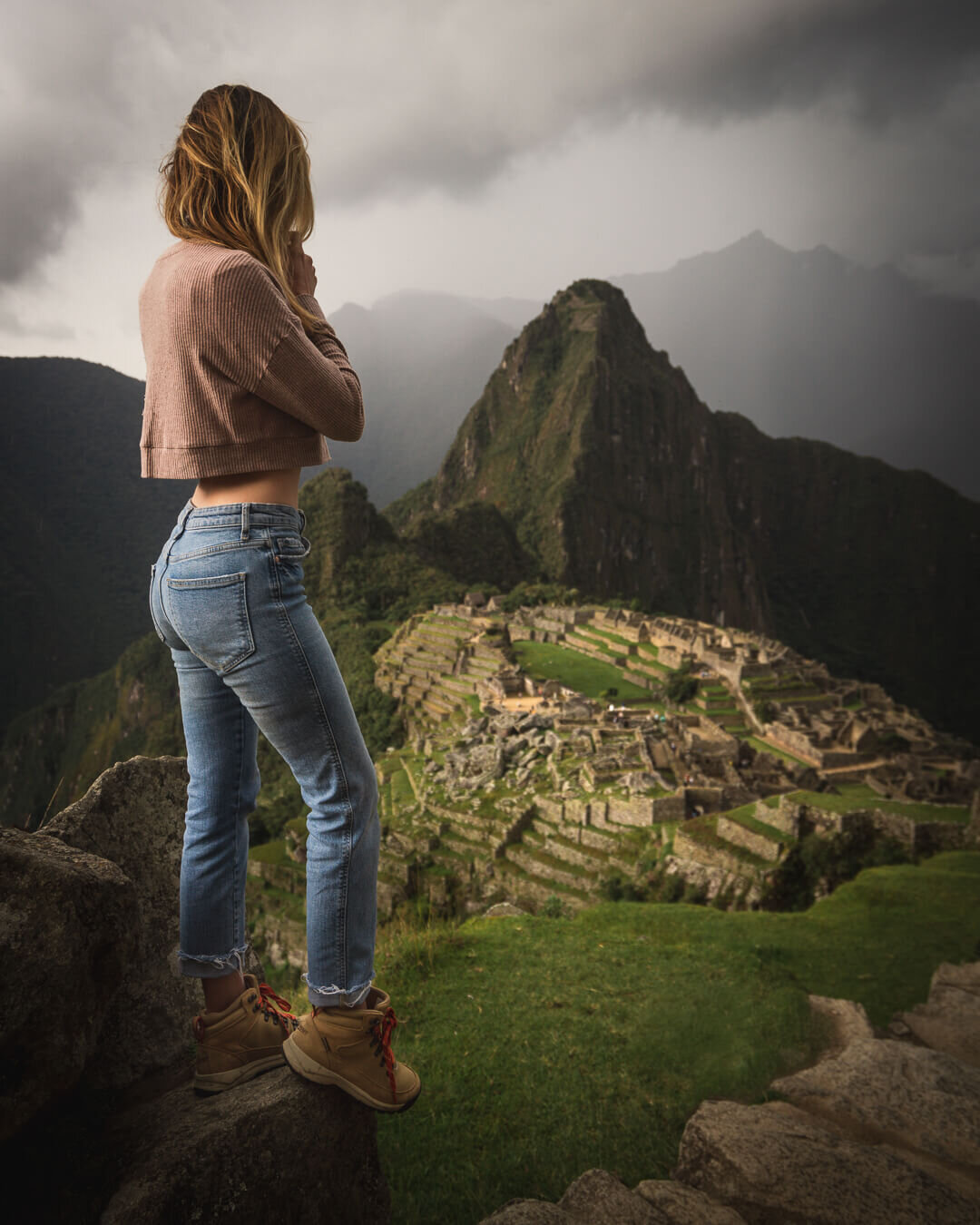
Machu Pichu
Most people take two-day to experience Machu Picchu, which allows them more time in Aquas Calientes. I get it. It’s a charming touristic small town with tons of shops, markets, and restaurants to explore – if that’s your thing.
We did Machu Picchu in one day. One afternoon really. And besides forgetting my rain jacket, I don’t have any regrets. I’m glad we went.
There’s a reason it’s one of the wonders of the world, and if you’re in the Cusco region, I’d make an effort to fit it into your itinerary – it’s one of the best things to do in Peru. This is if Machu Picchu isn’t the primary reason you’re in Peru in the first place!
Logistics: To visit Machu Picchu, you need an entrance ticket and your passport. You cannot buy entrance tickets at the Machu Picchu entrance, so you must purchase your ticket beforehand. There are a limited number of tickets available per day, so I’d recommend booking in advance – especially if you’re planning on visiting during the high season, or if your schedule is not flexible. You can do so online via the official government website.
As of 2019, many new rules exist at Machu Picchu to help it live up to its UNESCO world heritage site status. That means, unlike many of the other destinations in Peru, where most rules come in various shades of grey, your activities at Machu Picchu will be highly controlled and enforced.
Everything from what you eat and drink, to how big your backpack can be, and which direction you walk in is now highly regulated. But perhaps most importantly, you are no longer free to come and go as you please. You will need to purchase your ticket for either the morning or the afternoon time slot. There are pros and cons to both, but in general, the least busy time of day at the ruins is early morning (6 am-8 am) and late afternoon (2 pm-4 pm).
What To Pack For Peru
Due to Peru’s diverse range of climate zones—from rainforests to high altitude alpine regions—it can be a little tough to pack for. Whether you are there in the dry season or the wet season, I would plan on experiencing a little bit of everything. But that doesn’t mean you need to pack your entire wardrobe. A few key items can go a long way! This Peru packing list should help get you started.
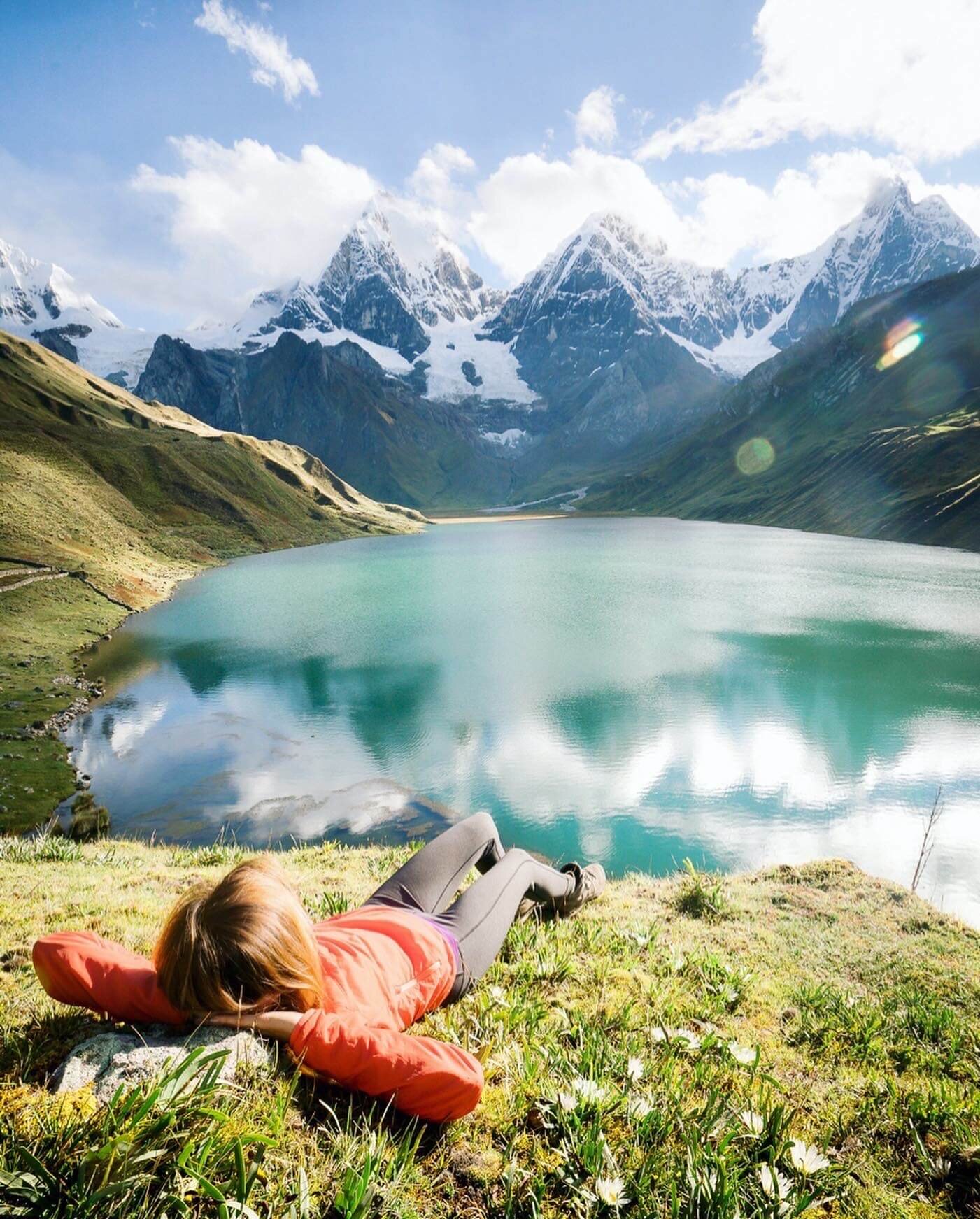
The second evening on the Cordillera Huayhuash Trek.
INSULATED LAYER –
I picked The North Face Summit L3 Down Hooded Jacket based on its stellar warmth to weight ratio. It’s been on every adventure with me since, and it hasn’t let me down (no pun intended)!
RAIN JACKET –
The Rab Kinetic Plus Hooded Jacket is hands down the best waterproof jacket I’ve owned. It’s breathable and super soft. I like it so much that I got Quin one for Christmas, and now it’s a staple in his outdoor apparel kit.
COZY FLEECE JACKET –
I’m endlessly amazed by how warm and cozy the Patagonia Better Sweater is. I’ve had mine for 3 years now and it still looks brand new despite the fact that I wear it all the time. Plus, it’s made from 100% recycled polyester fleece!
LEGGINGS –
There’s so many leggings out there to love. But it’s hard to beat Beyond Yoga leggings.
BASE LAYER –
The North Face HyperLayer Long Sleeve is a super light weight base layer. I love to pack this even when its warm outside because the UPF 30 protects my skin from strong high altitude UV rays.
DRESS –
I love dresses for their simplicity! You can dress them up, down, layer them, etc. Patagonia Seabrook Bandha Dress is a great staple to have in your travel wardrobe.
CASUAL SHOES –
When I travel I like my “casual shoes” to be multi-purpose. Functional to wear on a quick hike, yet cute enough to throw on with a pair of jeans. Blundstone Boots fit the bill perfectly. These classic boots will last forever, and they look great too! I also like my Danner Adrika Hiker Boot for this.
HIKING BOOTS –
For longer or more technical hikes, I own the Keen Terradoras, Danner Mountain 600 Hiking Boot, and La Sportiva Trail Running Shoe. Love them all!
WOOL SOCKS –
Wool socks are the best because you can wear them over and over and they don’t get stinky. Darn Tough Full Cushion Sock are a go-to of mine.
WARM HAT –
I slept with a beanie on every night of the trek. I like this Coal Headwear Beanie because it’s warm and I can pull the roll-up cuff down over my eyes to keep ambient light out while I’m trying to sleep.
REUSABLE WATER BOTTLE –
I’ve been on a few guided treks in Peru, some provided filtered water, some didn’t. Best to be prepared. Plus, I hate having to rely on other people to provide me with something as essential as clean water. The Grayl Ultralight Compact Water Purifier Bottle is a game changer. I used it throughout South America to filter tap water, river water, and everything in between.
If you are planning on doing a lot of hiking/trekking while you’re in Peru, check out my complete Hiking & Camping Gear Guide! It’s full of tried and true gear that has passed the test of time.
Please note that there might be some affiliate links in this post. If you do choose to purchase something, I may earn a small commission – at no additional cost to you. In addition, if you like to save money, you’ll receive 15% off your entire first order at Backcountry.com when you use JESS15 at checkout. As always, all ideas and opinions expressed in this post are entirely my own.
I appreciate your support! Happy adventuring!
– jess
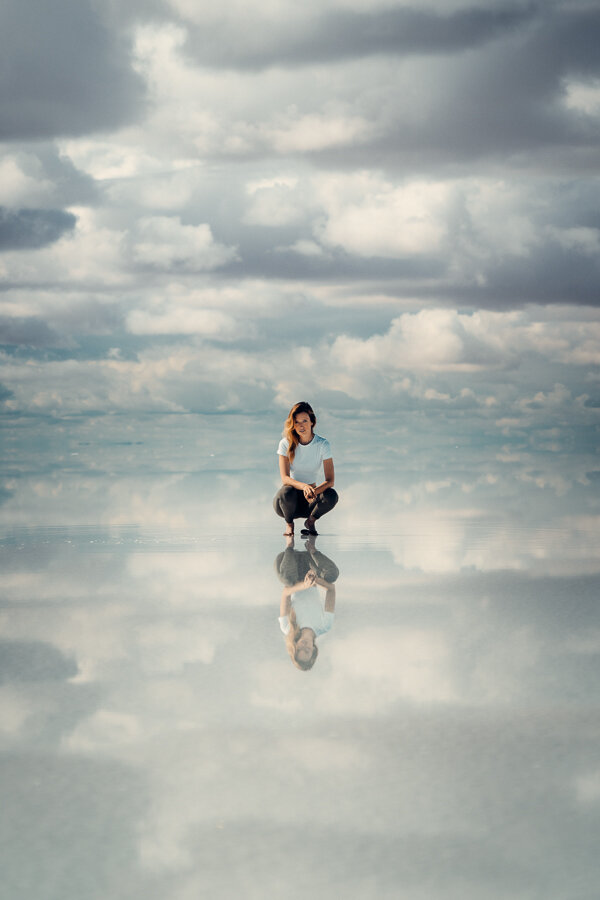
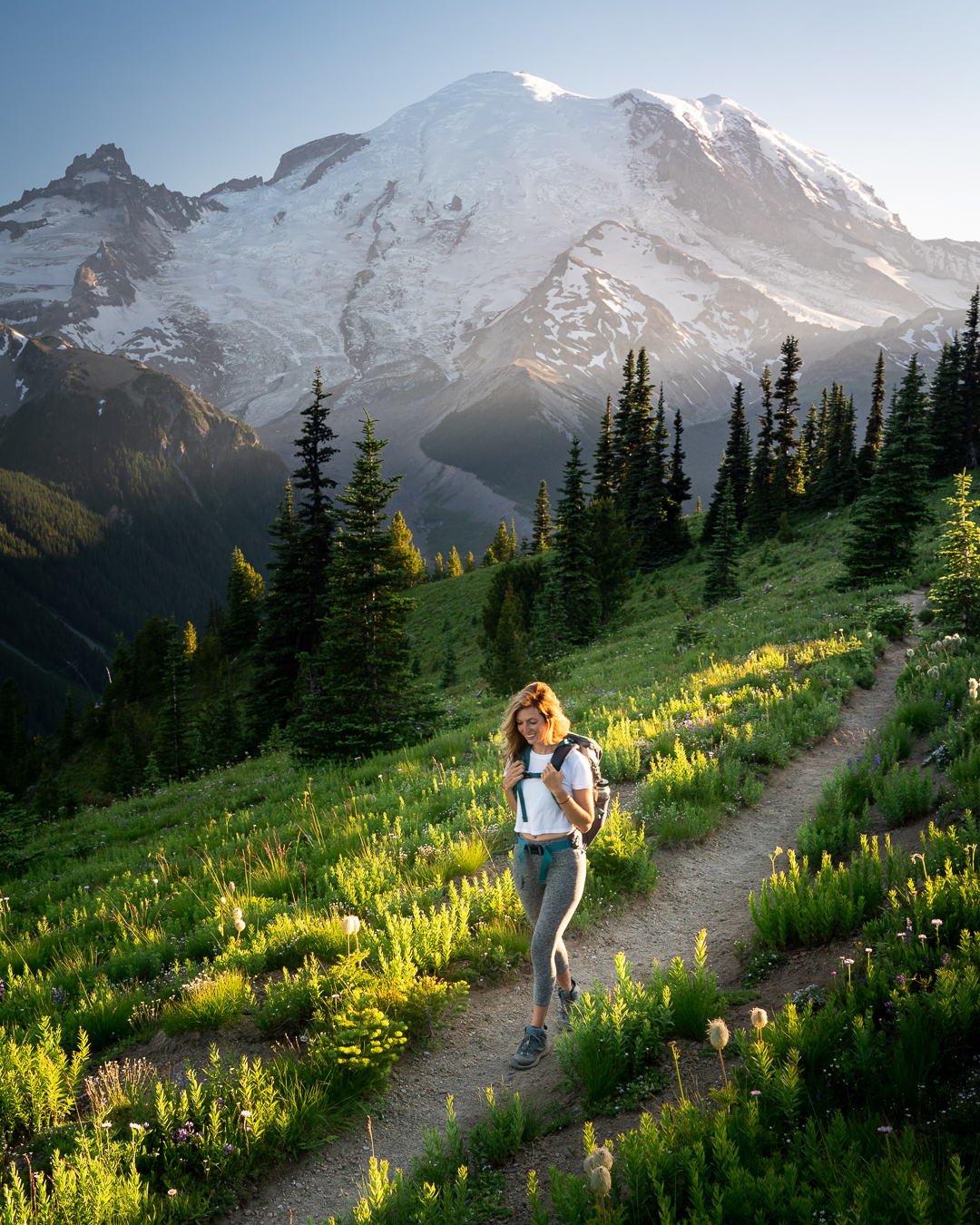
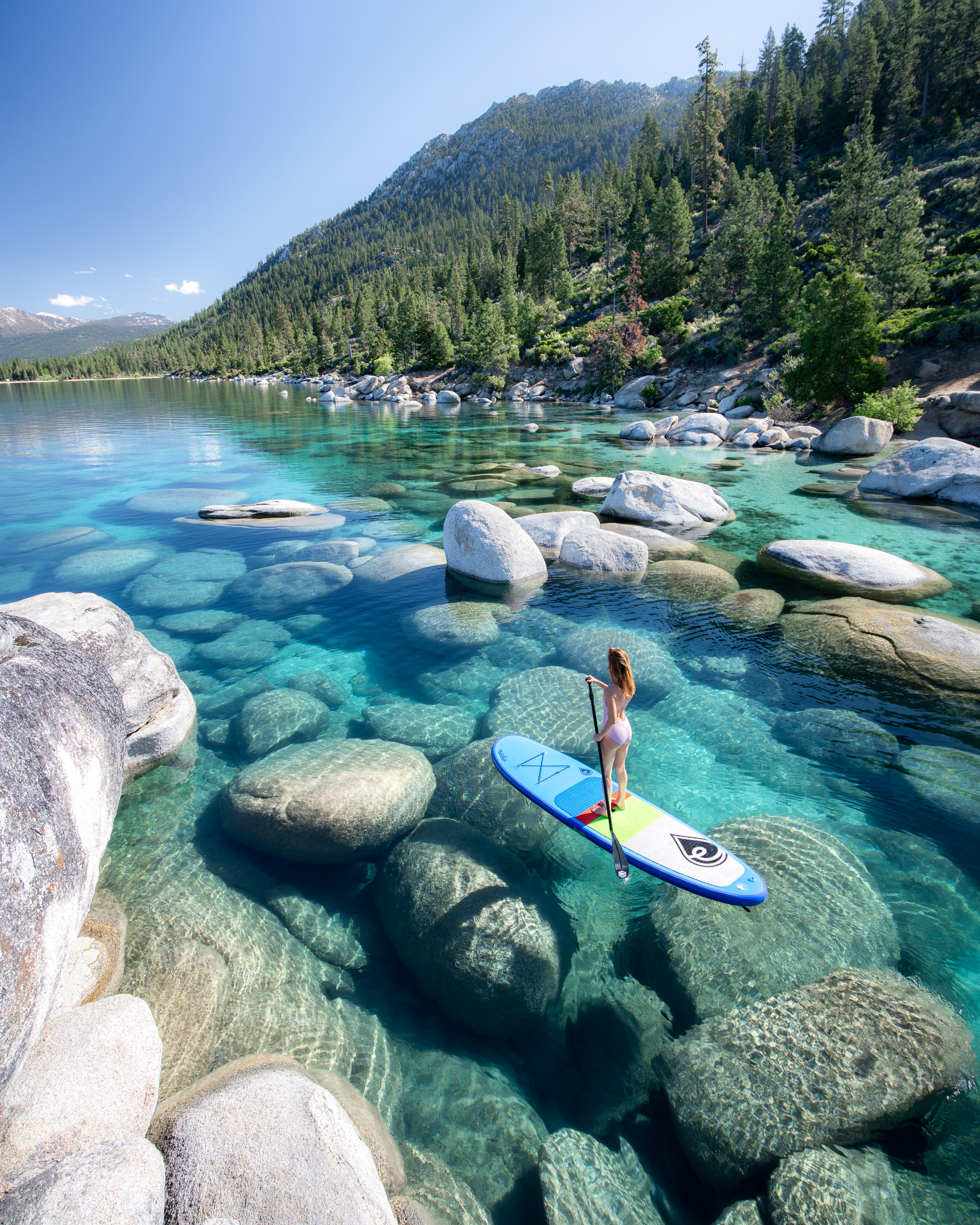
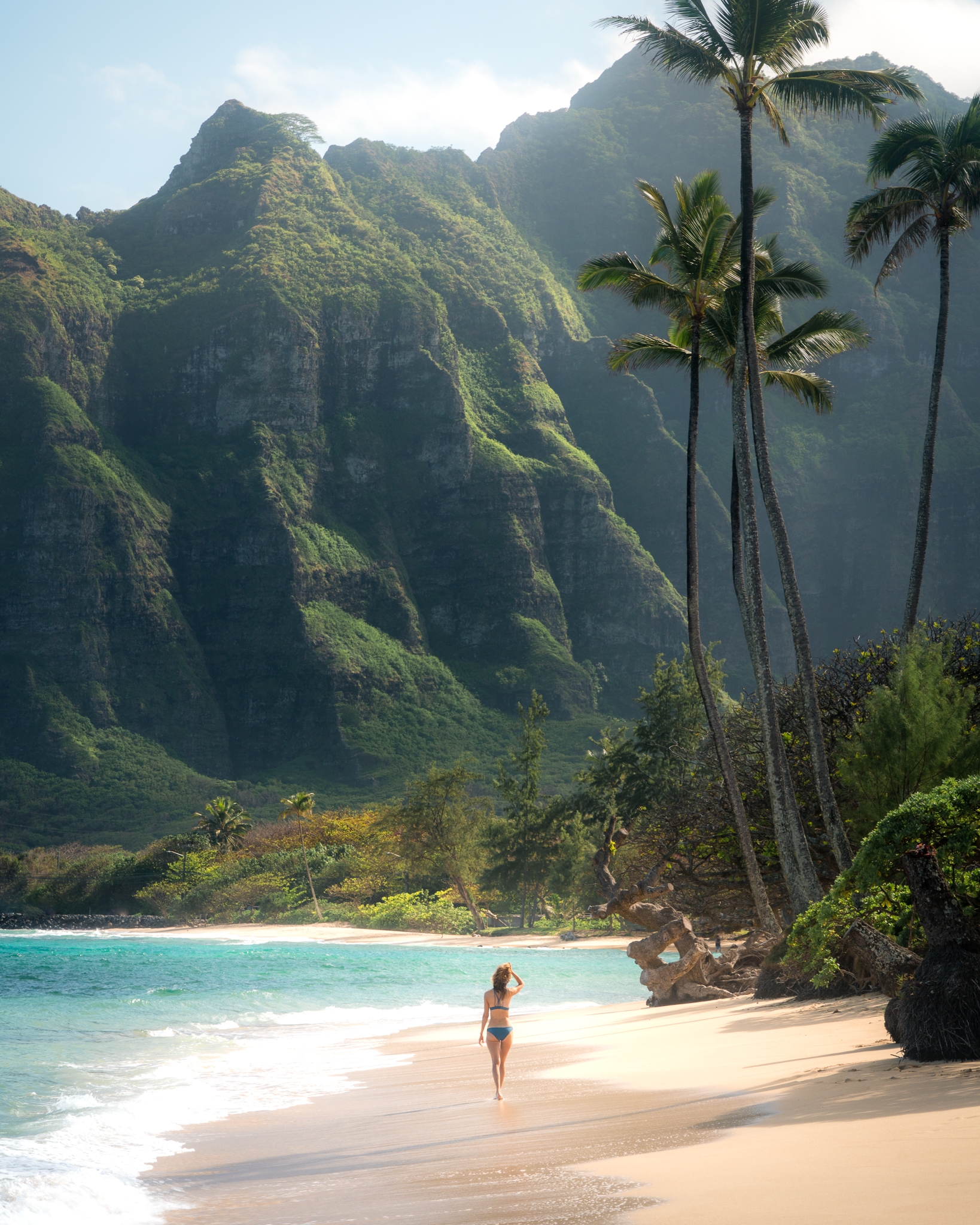
These photos are absolutely stunning Jess!! I can’t wait to visit Peru when it’s safe to travel again. Thanks for letting me travel from my couch today 🙂
Thank you so much Emily! It’s such a beautiful country. Hopefully, you can experience it in real life soon. 🙂
I was in Peru last year only for 10 days and it’s definitely not enough time to see all its wonders. Thanks for sharing this beautiful post and I will definitely be back!
I couldn’t agree more! There are so many things to see in Peru, I think you need at least 2 weeks. And if you plan on doing any of the longer treks you probably need more like 3 weeks to a month. There are still so many hikes I would like to go back for.
Jess,
Thank you for sharing your Peruvian adventure. And your amazing photos.
Thank you so much Kim!! So glad you enjoyed the post. 🙂
Hi Jess, how long were you in Peru when you did all of the above 9 things?
Hi Mariah! We visited these 9 places over the course of two seperate two week trips. The first trip was just to hike the Huayhuash, including Leguna 69, everything else was from the second trip.
Huge thanks for this post. Peru is on my list and i only had Machu Picchu as my must do but now I have to include these beautiful spots! Thanks again.
You’re so very welcome Jenita! There are so many beautiful places to see other than Machu Picchu in Peru. It’s one of my all-time favorite countries for natural beauty and culture. Have a wonderful time when you go!
Hi Jess! This is amazing – thank you for this post. We had planned a 2 week trip with many of these stops but it was of course cancelled due to COVID. Can you please tell me the name of the hotel with the swing? Thank you so much!
Hi Alex. I’m so sorry you had to postpone your trip. I’m afraid I don’t actually know the name of the hotel – we didn’t stay there and I forgot to write it down. But it’s in Soraypampa (a very tiny village), and you can’t miss it! It’s the only extreme swing on the hillside overlooking Salcantay Mountain.
Thanks for this post. So many Peru posts focus only on Machu Picchu. I haven’t been to Peru yet, so this will help my planning a lot.
Totally! Peru is such a stunning country. There’s no shortage of amazing things to see.
and Gocta fall
This will definitely help my planning, thank you! Curious, are all this pictures different trips and months? I’m trying to narrow down when to go, maybe shoulder seasons but would to know when you went 🙂
Hi! These photos were taken over the course of two different trips, one in March and one in May.
These are excellent suggestions. Thanks!
Wow, I’ve always wanted to visit Peru and your blog post has made me even more eager to do so! The pictures are stunning and I’m particularly interested in visiting Machu Picchu, can’t believe it’s only 1 day away from Cuzco. Have you tried any local food or drinks during your travels?
Beautiful pics! Your post has been really helpful for planning. If you had to choose between seeing Humantay or doing Ausungate trek, which would you choose? Did you take your van and sleep in Soraypampa? We are considering doing a van for a few nights vs doing a trek. Thank you!
Hi Kellee, thanks for the question! I’m sorry it took so long to get back to you. It would honestly depend on how much time I had and what area of Peru I was concentrating on. They are both incredible, and you wont regret either one. Humantay is significantly longer, but I think the remoteness and scale of the mountains probably give it a slight edge in my book. I’d be happy to do either again though!